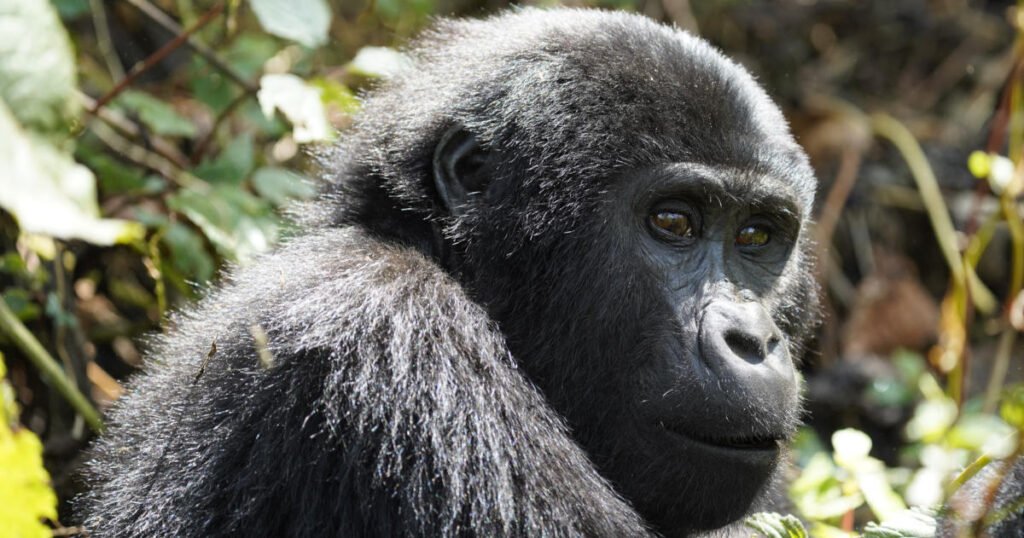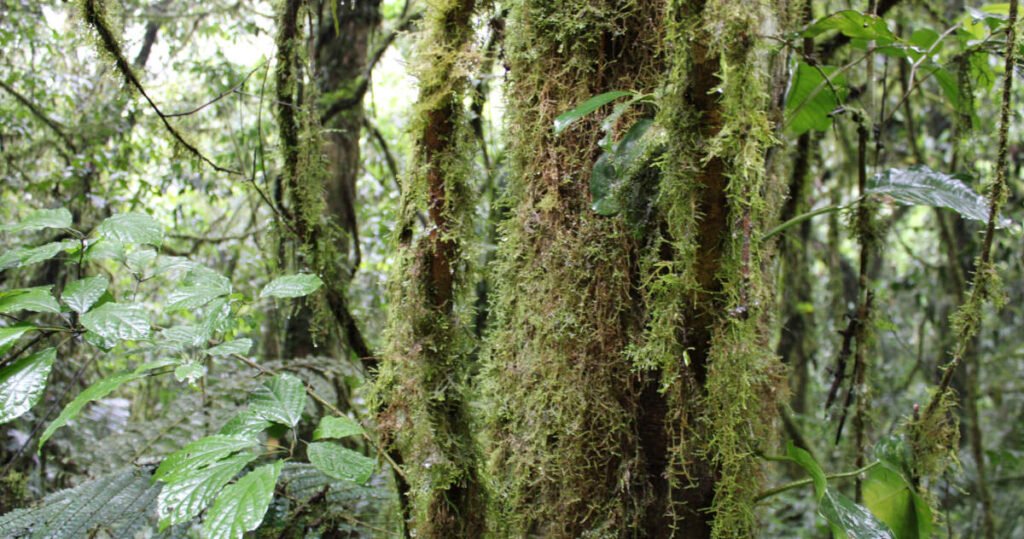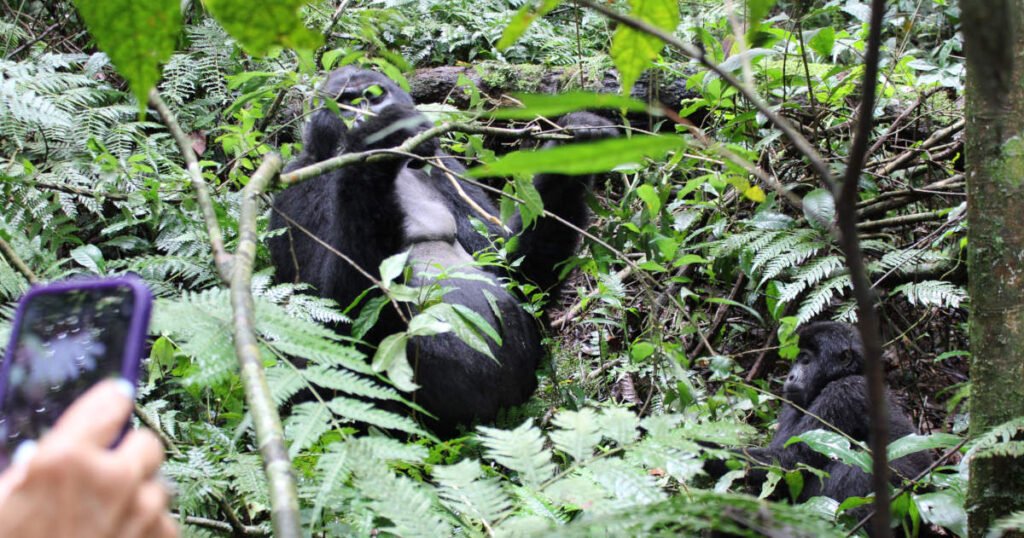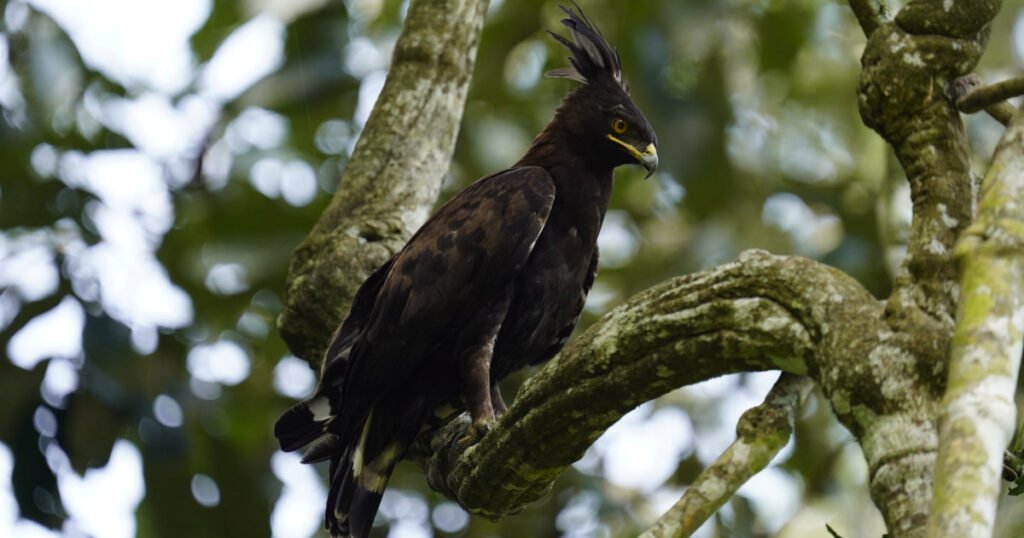The Gorilla Trekking Tours Guide
Gorillas in Africa
What is gorilla trekking? It is described as an exciting activity where tourists walk through gazetted African dense forests to see gorillas that are used to humans.
Trekking through Africa’s tropical forests is an exciting adventure. It allows you to see endangered gorilla families up close.
We appreciate your time spent visiting the gorillas. When you buy a gorilla permit, you help support mountain gorilla conservation. This effort ensures their survival for future generations.

Where do gorillas live?
Tropical rainforests thriving in Sub-Saharan Africa are home to African great apes. Over 1000 kilometers of Congo Basin forests separate the two species.
Western gorillas live in rainforests of several countries. They are: Congo, Cameroon, Gabon, Equatorial Guinea, Nigeria, Angola, and Central African Republic.
Eastern gorillas live in the mountains and lowlands of Central and East Africa. The Virunga Volcanoes stretch across the Democratic Republic of Congo, Rwanda, and Uganda. They are home to wild mountain gorillas.
In Uganda, Bwindi is the top spot to see these endangered animals. Eastern lowland gorillas’ location is East of the Democratic Republic of Congo.
Where to see Gorillas
East, Central, and West Africa are the only places to trek and see gorillas. Gorilla tourism in West and Central Africa is not developed to a pleasing standard. In contrast, East African countries like Uganda and Rwanda promote gorilla tours with enthusiasm. Prolonged civil war is a major challenge for the Democratic Republic of Congo. This country has three subspecies of gorillas that could attract trekkers. DRC faces challenges, but it keeps working hard to protect gorillas in its forests.

Why is seeing a mountain gorilla so trendy?
Mountain gorilla, or gorilla beringei beringei, is a subspecies of the Eastern gorilla. Their threatened population is increasing with 1,063 mountain gorillas in the wild. This number comes from the 2018 census. The census was in Bwindi and Sarambwe nature reserve, along with the Virunga massif.
Uganda has more than half of these mountain gorillas. This allows many gorilla families to be available for trekking. Other gorillas are in Rwanda and the Democratic Republic of Congo (DRC).
Eastern gorillas are well-known as the largest living primates. They resemble humans in many ways. Attempts to keep mountain gorillas in captivity have often failed. Thus, adventurers trek in Bwindi Impenetrable National Park to see them. While other gorilla species may be in zoos. Mountain gorillas live in the montane forests of Uganda, DRC, and Rwanda.
Best Gorilla Trekking Tours
Gorilla tourism focuses on the mountain gorillas found in East Africa, particularly in Uganda and Rwanda.
These countries guarantee a 99 percent success rate of seeing gorillas. Wild gorillas here have grown accustomed to human presence, making it safe for tourists.
Bwindi and Mgahinga National Parks are important for their large gorilla populations. Uganda is home to over fifty percent of the world’s mountain gorillas. The rest live in DRC and Rwanda.
UNESCO and IUCN commend Bwindi for its unique plants and animals. They highlight it as a top gorilla safari destination.
UNESCO named Bwindi Impenetrable Forest a World Heritage Site in Uganda. The IUCN backs ongoing conservation efforts in the area.
Rwanda hasn’t introduced mountain gorilla habituation for tourists. Still, you can trek in Volcanoes National Park.
In Bwindi, both trekking and habituation safaris are available.
Before trekking, it is wise to know gorilla facts. “Knowledge is power.” Embark on this bucket list experience filled with specifics on gorillas.
Brief gorilla facts
Did you know there are four gorilla subspecies?
Gorillas are the biggest living primates native to Africa. These shy, gentle apes exist as two species: the Western gorilla and the Eastern gorilla. The Western gorilla has two subspecies: Western lowland gorilla and Cross River gorilla. Subspecies of the Eastern gorilla are the Eastern lowland gorilla and Mountain gorilla.
Facts to find out during gorilla trekking.
While trekking, you are free to ask some questions like what gorillas eat, their age, family, and any other relevant questions.
Gorilla weight and height
Gorillas are the largest primates. Adult male silverbacks weigh between 135 and 200 kilograms. Adult females weigh from 68 to 110 kilograms. Very few apes are heavier.
All gorilla species stand 90 to 115 centimeters (3 to 4 feet) on all fours. When upright, they reach 138 to 183 centimeters (4 to 6 feet).
How long do gorillas live?
Africa’s gorillas live in the wilderness up to 40 years of age and do not usually live beyond 50 years. But Colo, a captive ape, died at 60 years old.
Human activity is threatening apes every day. Luckily, conservation efforts have boosted gorilla populations.
What do gorillas eat?
Africa’s tropical rainforests are a huge source of food for gorillas.
Thousands of plant species flourish in these virgin forests. Gorillas eat leaves, shoots, fruits, and some insects. They forage the whole day. Gorillas sleep throughout the night on the nests they make every day at dusk.
Gorilla Family
A troop is the term for a group of gorillas. These apes are social and are usually led by a dominant silverback or a small group of silverbacks. Families consist of about 4 to 30 members. In Uganda, several habituated gorilla families are open to tourists for trekking safaris.
Gorilla Habituation
Gorilla habituation is when gorillas get used to humans and no longer see them as a threat. This makes getting close to them a thrilling experience. Troops of mountain gorillas stay in Uganda’s Bwindi forest. This park has the largest population of these animals.
Trekking through the forest to see gorillas is a key part of Uganda safaris. You’ll join conservationists, researchers, and rangers on this adventure. On a trekking safari, you spend one hour with the gorillas. In a habituation exercise, you have four hours with them.
A gorilla habituation permit costs $1,500 in Uganda. These permits are very popular, so it’s best to book several months in advance.
Are mountain gorillas dangerous or friendly during gorilla trekking?

Gorillas are shy and reserved around people. They are gentle but can become aggressive if you are threatening or making sudden movements. During the trekking trip, you will be told not to make eye contact with mountain gorillas. There are set gorilla tracking guidelines and rules that must be followed during the entire safari.
A silverback may see you as a threat if you maintain eye contact. If a silverback feels threatened, you should look down and crouch as a sign of submission. If you run, it may chase and bite you.
Generally, habituated gorillas are safe unless you provoke them. You don’t have much to worry about. While trekking, trained park rangers are with you, and the gorillas are used to them. Wild gorillas, on the other hand, shy away from humans unless they are habituated.
The demand for gorilla tourism is rising, leading to more gorillas being habituated. Dian Fossey introduced gorillas to the world but opposed gorilla tourism. Wild gorillas always stay away from humans for safety. The more gorillas are habituated, the higher the risk of harm from humans.
Several gorilla groups are now habituated for tourism in Uganda, Rwanda, and the Democratic Republic of Congo.
What is a gorilla trekking permit?
A Uganda or Rwanda gorilla permit is a card or document that lets you join gorilla habituation or trekking.
You can visit Uganda’s game parks for drives right away with instant payment. Visitors can see gorillas in their lush forests only in limited ways with advance payment.
Planning a gorilla trek earlier is necessary. Knowing how to secure a Uganda gorilla permit is also necessary. Getting last-minute gorilla permits can be very costly and challenging. Contact us in advance to reserve gorilla tracking permits. During peak seasons, securing a gorilla permit is almost impossible. Always book in advance to avoid disappointment.
Gorilla permit cost.
Uganda and Rwanda, the main gorilla destinations, have different permit costs. Rwanda aims for luxury and charges $1,500, while Uganda provides permits for $700. The Uganda option suits budget, mid-range, and luxury visitors. Budget tourists prefer Uganda because of the lower fees charged.
Rwanda’s gorilla tracking permit cost is equivalent to two permits in Uganda. This is because of high conservation and operating costs. Thus, Rwanda’s gorilla safaris are the most expensive compared to gorilla safaris in the Democratic Republic of Congo and Uganda. The lower permit fees in Uganda have benefited many tourists who buy them off without hesitation.
Gorilla Trekking Uganda
Popular Uganda gorilla safaris include 3-day, 2-day, and 1-day trips. The 3-day gorilla trek safari is the most popular. We specialize in custom safaris. Ask us to create a safari that fits your needs, especially one that includes game drives.
Your safari experience depends on how many days you set aside for your Uganda gorilla tours. Start by booking an international flight to Uganda or Rwanda. Our guide will meet you at Entebbe or Kigali airport. You then proceed to Bwindi or Mgahinga National Park. If you have time before or after your trek, consider a game drive in Uganda’s parks.
3-Day Gorilla Trek in Uganda
Enjoy the stunning countryside as you travel from Kampala to Bwindi on day one. You’ll arrive in the evening at the Impenetrable Forest to check in at the lodge of your choice.
After the long journey to the countryside, rest and eat, preparing for the most important activity in the morning. The guide will escort you to the park offices for a briefing before searching for gorillas begins.
2-Day Gorilla Trek in Uganda
Travel to Bwindi from Rwanda on day one. Check in at your lodge to dine and rest for the next day’s activity.
On day two, trek early to see the gorillas. Many attractive plants and other animals will be seen along the trekking trails. After the tour, we will drive back to Rwanda, viewing rolling hills along the way decorated with farmlands.
1-Day Gorilla Tours
The 1-day gorilla tour is a quick trip to see mountain gorillas in Bwindi or Mgahinga National Park. This tour is great for those in Kisoro, Kanungu, Rubanda, and Kabale. If you’re in Rwanda, you can still enjoy a 1-day trek in Uganda’s parks. The drive from Kigali to your trekking spot takes about three hours, starting at 3:30 a.m. or the night before. Book a trip or read more about the detailed itinerary for the 1-day gorilla trekking tour.

Trekking expectations
Planning to stay at your safari lodge the night before trekking is smart. Eat, drink, and rest to boost your energy for the early trek.
Your safari guide or driver will take you from the lodge to the park’s office for a briefing at 7:30 AM. Other trekkers will join you, making a total of up to eight trekkers, not including rangers and guides.
Choose accommodation near the gorilla group you booked to avoid being late for the morning briefing. Please be punctual.
Searching for the great apes begins after the park staff welcomes and briefs you. Don’t worry about the trek’s difficulty. Many who have trekked for gorillas say it’s moderate and not too tough. If you don’t want to carry items while trekking, hire a Uganda gorilla safari porter. This helps reduce poaching since some porters were former poachers.
Expect moderate trekking difficulty. Park teams know where the gorillas spend the night. The tracking team stays in constant touch with the rangers leading you. There is no need for concern about the trek or the apes; excitement awaits when you see these endangered creatures.
The Great Gorilla Encounter.
When the trekking team finally encounters the gorillas, some trekkers wonder if these apes are a lost human race living in the forest. At that moment, grab your no-flash digital camera and capture the best shots of these shy great apes. You can spend up to 1 hour with them, enjoying their play, feeding, and climbing trees like Prunus Africana and bamboo.
The old-growth forests of tropical Africa are not only home to gorillas. They also harbor beautiful plants and animals in their ecosystem. You might see different animals on your trek. Watch for chimpanzees, sitatungas, elephants, duikers, monkeys, and baboons. You might also see bush pigs, chameleons, frogs, insects, and birds. Good luck!
After gorilla trekking, you are also free to enjoy nature walks and community visits in gorilla parks for more adventure. These activities start at 2:00 PM.
Additional Safari Activities.
Trekking to see the great African apes is usually combined with other exciting activities. These include:
- Birding
- Golden monkey trekking
- Cultural tours
- Mountain hiking
- Nature walks.
The park scenery is stunning, featuring forests, rivers, swamps, mountains, and lakes. It is wise to enjoy all these activities during your trip.
Bird Watching
A bird-watching safari in Africa’s lush tropical rainforests is always rewarding. The Afrotropical avifauna species are unique. The Albertine Rift is a rich ecosystem known for its diverse birdlife. Countries like Uganda, Rwanda, Burundi, and Tanzania form this stunning area, stretching over 1,000 kilometers.

Uganda, Rwanda, and DRC offer the best birding spots in East Africa. Uganda’s Bwindi Impenetrable National Park is a key bird habitat. It has more than 347 bird species recorded. The Buhoma and Ruhija sectors are famous for both birding and trekking safaris. Local guides excel at showing you the best birding sites in Uganda. When you request a guide for your safari, you can expect to see many of the birds that call the Pearl of Africa home.
On a birding safari in Bwindi, you can find rare species like;
- Chapin’s Flycatcher
- Brown-cheeked Hornbill
- Grauer’s Swamp-warbler
- Grauer’s Broadbill
Endangered birds include the Grey Parrot and Shelley’s Crimsonwing. This biodiversity hotspot offers plenty of birdwatching opportunities.
Guided Nature Walks
Walking through the beautiful scenery of great ape parks sets Uganda’s gorilla safaris apart. The Ivy River and Kashasha River trails are moderate hikes where you’ll encounter rich wildlife in the ancient Bwindi Forest.
The Munyaga River Falls trail is an easy hike that leads to a stunning waterfall. This trail in Buhoma is home to many birds and monkeys.
Cultural Tours and Gorilla Trekking
The local Ugandan communities around Bwindi are the Batwa, Bafumbira, and Bakiga. The skilled farmers in this area are the Bafumbira and Bakiga. The terraced farmlands on the way to gorilla treks display the hard work invested in cultivating this part of southwestern Uganda. A large part of the vegetables for urban areas in Uganda and Rwanda comes from around Bwindi.
The Batwa, a pygmy tribe, lived in Bwindi and Mgahinga Gorilla National Park. This was before these areas became conservation zones. As hunter-gatherers, the Batwa are native to Central Africa’s tropical forests. They relocated to allow for conservation in these parks. The Bwindi Twa people now live at the forest’s edges.
Visiting these communities offers a great experience. Cultural dances are a highlight. A community tour can complement your birding or gorilla safari.
Golden Monkey Trekking
Mgahinga Gorilla National Park is well-known for its mountain gorilla tracking and golden monkey treks. Both species face endangerment. This breathtaking park is part of the Virunga Volcanoes, a forested mountain area shared by the DRC, Rwanda, and Uganda.
Other unique opportunities in Mgahinga include birding, hiking, and the Batwa cultural trail. It is the smallest park in Uganda, hosting over 76 mammal species and 180 bird species.
Mountain Hiking
The Virunga Massif is a volcanic area featuring Muhabura (4,127 m), Gahinga (3,474 m), and Sabyinyo (3,645 m). Hiking to the peaks of these volcanoes is exhilarating, with each mountain presenting its own challenges. Mount Sabyinyo is the most popular and demanding hike. Its peak marks the border of Uganda, Rwanda, and the DRC. Hiking each volcano offers chances to see wildlife, lush vegetation, and stunning views. After the trekking safari in Bwindi or Mgahinga, rest up and hike the Virunga Volcanoes the next day.
Enjoy more Uganda safaris after trekking in Bwindi and Mgahinga. The two parks are just 25 km apart. Bwindi is also close to Queen Elizabeth National Park. Other parks like Lake Mburo, Murchison Falls, and Kibale are worth exploring too, as they’re on the way to or from Bwindi, a gorilla trekking destination.
